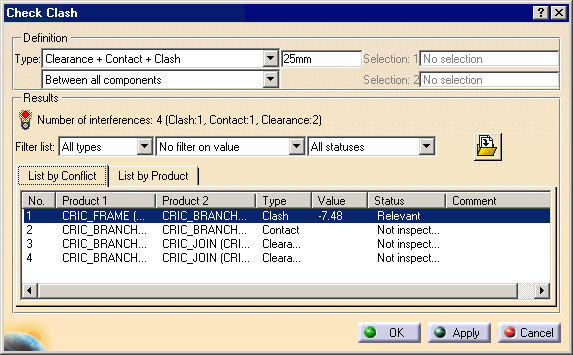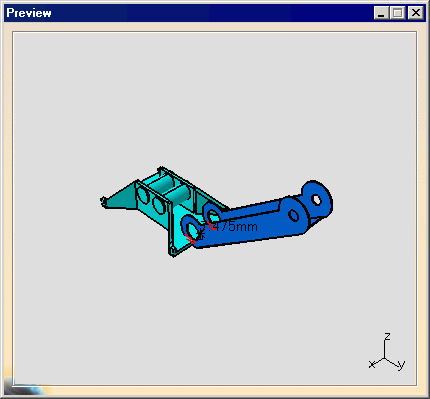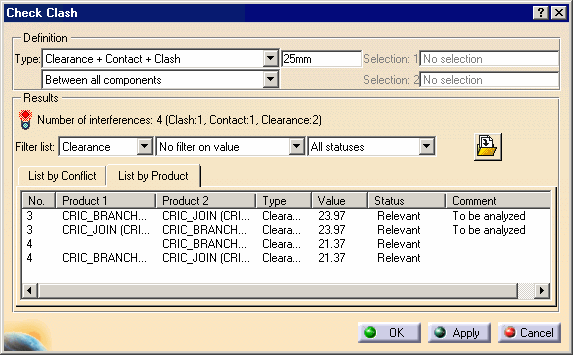See also About Interference Analysis for further details.
-
Set the interference type to Clearance + Contact + Clash.
-
Enter 25mm as desired clearance value in the field that becomes active next to the interference type.
-
Select the computation type to Between all components.
-
Click Apply.
The Check Clash dialog box displays the following results.

The Check Clash dialog box identifies the number of interferences detected along with the type: four interferences have been detected.
Status lights are color-coded as follows:
-
Red: at least one conflict is Relevant.
-
Yellow: no relevant conflicts, at least one conflict is Not inspected.
-
Green: all conflicts are Irrelevant.
Filter list allows you to filter:
-
By type:
-
All types
-
Clash
-
Contact
-
Clearance
-
-
By value:
-
No filter on value
-
Increasing value
-
Decreasing value
-
-
By status:
-
All statuses
-
Inspected
-
Relevant
-
Irrelevant
-
Interference results are presented in two different ways in the dialog box:
-
List by Conflict tab: lists results by conflict with one conflict per line.
-
List by Product tab: lists results by product. There may be more than one conflict per product.
-
Select the first conflict in the list, that is a clash, to run a detailed computation.
A Preview window appears showing the products in conflict only.

The minimum distance is specified in the dialog box and both the minimum distance and red intersection curves identify clashing products separated by less than the specified clearance distance of 25mm are displayed in the geometry area.
Color Coding for Conflicts:
-
Clash: red intersection curves identify clashing products.
-
Contact: yellow triangles identify products in contact.
-
Clearance: green triangles identify products separated by less than the specified clearance distance.
If necessary, pan, zoom and/or rotate in the Preview window to visualize the interference better.
-
Select contact and clearances in turn in the List by Conflict tab to run a detailed computation.
As you select them, the Value and Status columns in the Check Clash dialog box, and the Preview window are updated.
-
You can also view the selected interference in a dedicated viewer. To do so, click the Results window icon:

Filtering the Display in the Dialog Box
You can filter the display of results in tabs by:
-
All types.
-
Type of interference: clash, contact or clearance.
-
Value: no filter, increasing value or decreasing value.
-
Status: all, not inspected, relevant, irrelevant. Until selected, all interferences are reported not inspected. Inspected interferences can be relevant or irrelevant.
-
Set Clearance as the filter type.
-
To change the status of an inspected conflict, click the Status field of the appropriate conflict.
The conflict status changes from relevant to irrelevant and vice-versa depending on the initial value.

-
Click the Comment field to add comments to the first conflict in the list.
The Comment dialog box appears.

-
Enter as To be analyzed comment and click OK.
-
Click the List by Product tab to display conflicts associated with products.

Results are organized by product in the List by Product tab. There may be more than one conflict per product.